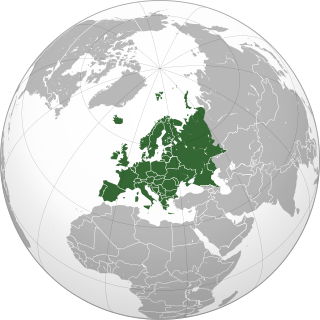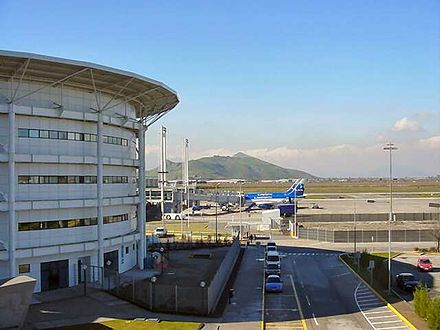Comodoro Arturo Merino Benítez International Airport | |||||||||||||||
|---|---|---|---|---|---|---|---|---|---|---|---|---|---|---|---|
 | |||||||||||||||
| Summary | |||||||||||||||
| Airport type | Public and Military | ||||||||||||||
| Operator | Nuevo Pudahuel | ||||||||||||||
| Serves | Santiago | ||||||||||||||
| Location | Pudahuel, Santiago Metropolitan Region, Chile | ||||||||||||||
| Hub for | |||||||||||||||
| Elevation AMSL | 1,555 ft / 474 m | ||||||||||||||
| Coordinates | 33°23′34″S70°47′08″W / 33.39278°S 70.78556°W Coordinates: 33°23′34″S70°47′08″W / 33.39278°S 70.78556°W | ||||||||||||||
| Website | Nuevo Pudahuel | ||||||||||||||
| Map | |||||||||||||||
| Runways | |||||||||||||||
| |||||||||||||||
| Statistics (2017) | |||||||||||||||
| |||||||||||||||
Comodoro Arturo Merino Benítez International Airport (Spanish : Aeropuerto Internacional Comodoro Arturo Merino Benítez) ( IATA : SCL, ICAO : SCEL), also known as Santiago International Airport and NuevoPudahuel Airport, located in Pudahuel, 15 km (9.3 mi) north-west of downtown Santiago, is Chile's largest aviation facility and the busiest international airport in the country.

Spanish or Castilian is a Western Romance language that originated in the Castile region of Spain and today has hundreds of millions of native speakers in the Americas and Spain. It is a global language and the world's second-most spoken native language, after Mandarin Chinese.
An IATA airport code, also known as an IATA location identifier, IATA station code or simply a location identifier, is a three-letter code designating many airports around the world, defined by the International Air Transport Association (IATA). The characters prominently displayed on baggage tags attached at airport check-in desks are an example of a way these codes are used.

The ICAOairport code or location indicator is a four-letter code designating aerodromes around the world. These codes, as defined by the International Civil Aviation Organization and published in ICAO Document 7910: Location Indicators, are used by air traffic control and airline operations such as flight planning.
Contents
- History
- Early years
- 1994 expansion
- Second runway
- 2020 Master plan and expansion
- Passenger terminal
- Shopping
- Restaurants
- Airline lounges
- Hotels
- Military functions
- Airlines and destinations
- Passenger
- Cargo
- Statistics
- Ground transportation
- Roads
- Taxi and shuttle services
- Bus
- Rental services
- Accidents and incidents
- See also
- References
- External links
Arturo Merino Benítez International Airport has domestic and international services to destinations in Europe, Oceania, Asia and the Americas. In 2011 it was the ninth busiest airport in Latin America and the sixth busiest in South America by passenger traffic. It was the seventh busiest airport in Latin America by aircraft movements, serving 124,799 operations. [2] Its location in Chile's most populated area, as well as in the central part of the country makes of it an ideal main hub and maintenance center for most local airlines such as LATAM and Sky Airline. LATAM Airlines accounts for approximately 82% of the airport's total commercial operations. [3]

Europe is a continent located entirely in the Northern Hemisphere and mostly in the Eastern Hemisphere. It is bordered by the Arctic Ocean to the north, the Atlantic Ocean to the west and the Mediterranean Sea to the south. It comprises the westernmost part of Eurasia.

Oceania is a geographic region comprising Australasia, Melanesia, Micronesia and Polynesia. Spanning the eastern and western hemispheres, Oceania covers an area of 8,525,989 square kilometres (3,291,903 sq mi) and has a population of 40 million. Situated in the southeast of the Asia-Pacific region, Oceania, when compared to continental regions, is the smallest in land area and the second smallest in population after Antarctica.

Asia is Earth's largest and most populous continent, located primarily in the Eastern and Northern Hemispheres. It shares the continental landmass of Eurasia with the continent of Europe and the continental landmass of Afro-Eurasia with both Europe and Africa. Asia covers an area of 44,579,000 square kilometres (17,212,000 sq mi), about 30% of Earth's total land area and 8.7% of the Earth's total surface area. The continent, which has long been home to the majority of the human population, was the site of many of the first civilizations. Asia is notable for not only its overall large size and population, but also dense and large settlements, as well as vast barely populated regions. Its 4.5 billion people constitute roughly 60% of the world's population.
The airport is owned by the Chilean government and has been operated since October 2015 by Nuevo Pudahuel, a consortium of companies formed by Aéroports de Paris (France), Vinci (France) and Astaldi (Italy). Air traffic control is handled by the Directorate General of Civil Aviation (Chile).
Vinci, corporately styled VINCI, is a French concessions and construction company founded in 1899 as Société Générale d'Enterprises. It employs over 194,000 people, operates in more than 100 countries and is the largest construction company in the world by revenue. Vinci is listed on Euronext's Paris stock exchange and is a member of the Euro Stoxx 50 index. Its head office is in Rueil-Malmaison, in the western suburbs of Paris.
Astaldi S.p.A. is an Italian multinational major construction company based in Rome, Italy. The group is active in the fields of civil engineering, hydraulic engineering, electromechanical engineering and transportation.
The Directorate General of Civil Aviation or the Directorate General of Civil Aeronautics of Chile is the civil aviation authority of Chile. It has its headquarters in Providencia, Santiago. The Directorate was created in March 1930, following the setup of the Chilean Air Force.
Its ICAO category is 4F. The airport functions as a joint civil-military facility. It is the headquarters of the Chilean Air Force 2nd Air Brigade and where its 10th Aviation Group is based.

The Chilean Air Force is the air force of Chile, a branch of the Chilean military.
Santiago International is the longest non-stop destination for most European carriers including Iberia, Air France, Alitalia and British Airways from their respective hubs in Madrid-Barajas Airport, Paris–Charles de Gaulle, Rome–Leonardo da Vinci–Fiumicino Airport and London–Heathrow Airport. In addition, LATAM flies to Frankfurt a via Madrid.
Air France, stylized as AIRFRANCE, is the French flag carrier headquartered in Tremblay-en-France. It is a subsidiary of the Air France–KLM Group and a founding member of the SkyTeam global airline alliance. As of 2013 Air France serves 36 destinations in France and operates worldwide scheduled passenger and cargo services to 168 destinations in 78 countries and also carried 46,803,000 passengers in 2015. The airline's global hub is at Charles de Gaulle Airport with Orly Airport as the primary domestic hub. Air France's corporate headquarters, previously in Montparnasse, Paris, are located on the grounds of Charles de Gaulle Airport, north of Paris.
Alitalia – Società Aerea Italiana, operating as Alitalia, is the flag carrier of Italy. The company has its head office in Fiumicino, Rome, Italy. Its main hub is Leonardo da Vinci-Fiumicino Airport, Rome, and a secondary is Linate Airport, Milan. Other focus airports are Catania-Fontanarossa Airport, Milan-Malpensa Airport, Palermo Airport and Naples Airport. In 2018, it was the twelfth-largest airline in Europe. The name "Alitalia" is an Italian portmanteau of the words ali (wings), and Italia (Italy).
British Airways (BA) is the flag carrier and the second largest airline in the United Kingdom based on fleet size and passengers carried, behind easyJet. The airline is based in Waterside near its main hub at London Heathrow Airport. In January 2011 BA merged with Iberia, creating the International Airlines Group (IAG), a holding company registered in Madrid, Spain. IAG is the world's third-largest airline group in terms of annual revenue and the second-largest in Europe. It is listed on the London Stock Exchange and in the FTSE 100 Index.
The airport is also South America's main gateway to Oceania, with scheduled flights to Sydney, Auckland, Easter Island, Papeete and Melbourne. The Santiago – Rome non-stop flight operated by Alitalia is the longest flight to ever fly out of this airport.















